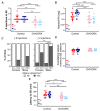This is a preprint.
Sex and gonadectomy modify behavioral seizure susceptibility and mortality in a repeated low-dose kainic acid systemic injection paradigm in mice
- PMID: 37292790
- PMCID: PMC10245840
- DOI: 10.1101/2023.05.22.541824
Sex and gonadectomy modify behavioral seizure susceptibility and mortality in a repeated low-dose kainic acid systemic injection paradigm in mice
Update in
-
Sex and gonadectomy modify behavioral seizure susceptibility and mortality in a repeated low-dose kainic acid systemic injection paradigm in mice.Epilepsia Open. 2023 Dec;8(4):1512-1522. doi: 10.1002/epi4.12828. Epub 2023 Sep 23. Epilepsia Open. 2023. PMID: 37715318 Free PMC article.
Abstract
Objective: Sex differences in epilepsy appear driven in part due to effects of gonadal steroids, with varying results in experimental models based on species, strain, and method of seizure induction. Furthermore, removing a main source of these steroids via gonadectomy may impact seizure characteristics differently in males and females. Repeated low-dose kainic acid (RLDKA) systemic injection paradigms were recently shown to reliably induce status epilepticus (SE) and hippocampal histopathology in C57BL/6J mice. Here, we investigated whether seizure susceptibility in a RLDKA injection protocol exhibits a sex difference, and whether gonadectomy differentially influences response to this seizure induction paradigm in males and females.
Methods: Adult C57BL/6J mice were left gonad-intact as controls or gonadectomized (females: ovariectomized, OVX; males: orchidectomized, ORX). At least 2 weeks later, KA was injected i.p. every 30 minutes at 7.5 mg/kg or less until the animal reached SE, defined by at least 5 generalized seizures (GS, Racine stage 3 or higher). Parameters of susceptibility to GS induction, SE development, and mortality rates were quantified.
Results: No differences in seizure susceptibility or mortality were observed between control males and control females. ORX males exhibited increased susceptibility and reduced latency to both GS and SE, but OVX females exhibited increased susceptibility and reduced latency to SE only. However, ORX males, but not OVX females, exhibited strongly increased seizure-induced mortality.
Significance: The RLDKA protocol is notable for its efficacy in inducing SE and seizure-induced histopathology in C57BL/6J mice, the background for many transgenic strains in current use in epilepsy research. The present results indicate that this protocol may be beneficial for investigating the effects of gonadal hormone replacement on seizure susceptibility, mortality, and seizure-induced histopathology, and that gonadectomy unmasks sex differences in susceptibility to seizures and mortality not observed in gonad-intact controls.
Conflict of interest statement
Conflicts of Interest
The authors have no conflicts of interest to disclose.
Figures




Similar articles
-
Sex and gonadectomy modify behavioral seizure susceptibility and mortality in a repeated low-dose kainic acid systemic injection paradigm in mice.Epilepsia Open. 2023 Dec;8(4):1512-1522. doi: 10.1002/epi4.12828. Epub 2023 Sep 23. Epilepsia Open. 2023. PMID: 37715318 Free PMC article.
-
Differential susceptibility to seizures induced by systemic kainic acid treatment in mature DBA/2J and C57BL/6J mice.Epilepsia. 1995 Mar;36(3):301-7. doi: 10.1111/j.1528-1157.1995.tb00999.x. Epilepsia. 1995. PMID: 7614915
-
Mouse strain differences in kainic acid sensitivity, seizure behavior, mortality, and hippocampal pathology.Neuroscience. 2003;122(2):551-61. doi: 10.1016/s0306-4522(03)00562-1. Neuroscience. 2003. PMID: 14614919
-
Repeated low-dose kainate administration in C57BL/6J mice produces temporal lobe epilepsy pathology but infrequent spontaneous seizures.Exp Neurol. 2016 May;279:116-126. doi: 10.1016/j.expneurol.2016.02.014. Epub 2016 Feb 16. Exp Neurol. 2016. PMID: 26896834 Free PMC article.
-
Status Epilepticus: Behavioral and Electroencephalography Seizure Correlates in Kainate Experimental Models.Front Neurol. 2018 Jan 23;9:7. doi: 10.3389/fneur.2018.00007. eCollection 2018. Front Neurol. 2018. PMID: 29410648 Free PMC article. Review.
References
-
- McHugh JC, Delanty N. Epidemiology and classification of epilepsy: gender comparisons. Int Rev Neurobiol. 2008; 83:11–26. - PubMed
-
- Christensen J, Vestergaard M, Pedersen MG, Pedersen CB, Olsen J, Sidenius P. Incidence and prevalence of epilepsy in Denmark. Epilepsy Res. 2007; 76(1):60–5. - PubMed
-
- Savic I. Sex differences in human epilepsy. Exp Neurol. 2014; 259:38–43. - PubMed
Publication types
Grants and funding
LinkOut - more resources
Full Text Sources
